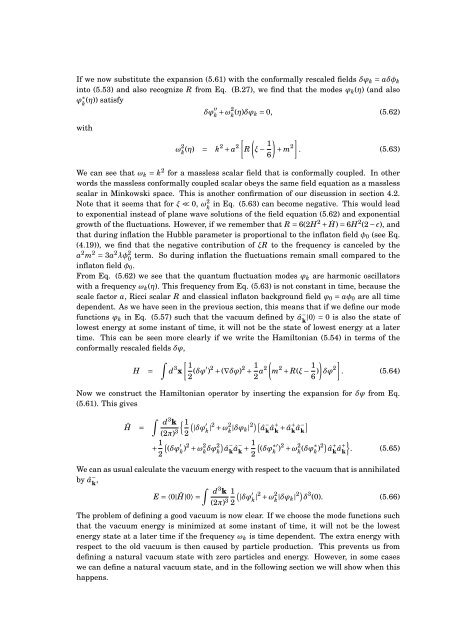Master's Thesis in Theoretical Physics - Universiteit Utrecht
Master's Thesis in Theoretical Physics - Universiteit Utrecht
Master's Thesis in Theoretical Physics - Universiteit Utrecht
Create successful ePaper yourself
Turn your PDF publications into a flip-book with our unique Google optimized e-Paper software.
If we now substitute the expansion (5.61) with the conformally rescaled fields δϕ k = aδφ k<strong>in</strong>to (5.53) and also recognize R from Eq. (B.27), we f<strong>in</strong>d that the modes ϕ k (η) (and alsoϕ ∗ k (η)) satisfy δϕ ′′ k + ω2 k (η)δϕ k = 0, (5.62)with(ω 2 k (η) = k2 + a[R2 ξ − 1 ) ]+ m 2 . (5.63)6We can see that ω k = k 2 for a massless scalar field that is conformally coupled. In otherwords the massless conformally coupled scalar obeys the same field equation as a masslessscalar <strong>in</strong> M<strong>in</strong>kowski space. This is another confirmation of our discussion <strong>in</strong> section 4.2.Note that it seems that for ξ ≪ 0, ω 2 <strong>in</strong> Eq. (5.63) can become negative. This would leadkto exponential <strong>in</strong>stead of plane wave solutions of the field equation (5.62) and exponentialgrowth of the fluctuations. However, if we remember that R = 6(2H 2 + Ḣ) = 6H 2 (2 − ɛ), andthat dur<strong>in</strong>g <strong>in</strong>flation the Hubble parameter is proportional to the <strong>in</strong>flaton field φ 0 (see Eq.(4.19)), we f<strong>in</strong>d that the negative contribution of ξR to the frequency is canceled by thea 2 m 2 = 3a 2 λφ 2 0term. So dur<strong>in</strong>g <strong>in</strong>flation the fluctuations rema<strong>in</strong> small compared to the<strong>in</strong>flaton field φ 0 .From Eq. (5.62) we see that the quantum fluctuation modes ϕ k are harmonic oscillatorswith a frequency ω k (η). This frequency from Eq. (5.63) is not constant <strong>in</strong> time, because thescale factor a, Ricci scalar R and classical <strong>in</strong>flaton background field ϕ 0 = aφ 0 are all timedependent. As we have seen <strong>in</strong> the previous section, this means that if we def<strong>in</strong>e our modefunctions ϕ k <strong>in</strong> Eq. (5.57) such that the vacuum def<strong>in</strong>ed by â − |0〉 = 0 is also the state ofklowest energy at some <strong>in</strong>stant of time, it will not be the state of lowest energy at a latertime. This can be seen more clearly if we write the Hamiltonian (5.54) <strong>in</strong> terms of theconformally rescaled fields δϕ,H =∫[ 1d 3 x2 (δϕ′ ) 2 + (∇δϕ) 2 + 1 (m2 a2 2 + R(ξ − 1 ] )δϕ6 ) 2 . (5.64)Now we construct the Hamiltonian operator by <strong>in</strong>sert<strong>in</strong>g the expansion for δϕ from Eq.(5.61). This givesĤ =∫+ 1 2d 3 k(|δϕ′k |2 + ω 2 k |δϕ k| 2)[ â − kâ+ k + ]â+ kâ− k{ 1(2π) 3 2((δϕ′k )2 + ω 2 k δϕ2 k)â−kâ− k + 1 ((δϕ∗′k2)2 + ω 2 k (δϕ∗ k )2) â + kâ+ k}. (5.65)We can as usual calculate the vacuum energy with respect to the vacuum that is annihilatedby â − k , ∫ d 3 k 1 (E = 〈0|Ĥ|0〉 =|δϕ′(2π) 3 k2|2 + ω 2 k |δϕ k| 2) δ 3 (0). (5.66)The problem of def<strong>in</strong><strong>in</strong>g a good vacuum is now clear. If we choose the mode functions suchthat the vacuum energy is m<strong>in</strong>imized at some <strong>in</strong>stant of time, it will not be the lowestenergy state at a later time if the frequency ω k is time dependent. The extra energy withrespect to the old vacuum is then caused by particle production. This prevents us fromdef<strong>in</strong><strong>in</strong>g a natural vacuum state with zero particles and energy. However, <strong>in</strong> some caseswe can def<strong>in</strong>e a natural vacuum state, and <strong>in</strong> the follow<strong>in</strong>g section we will show when thishappens.
















